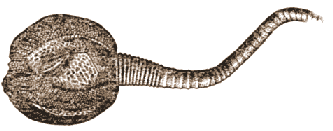Geology / Gallery

Lepocrinetes quadrifasciatus (12)
The 'cystoids' are one of the few groups that diversified greatly in the Silurian but never grew to huge numbers and became extinct by the Permian.
They are part of the large and complex group of Echinoderm ➚ group of animals that includes the modern starfish and sea urchins. This group lived anchored to rocks in shallow water filtering out food particles with the 'head' structure. They had a complex pore structure that helped to cope with low oxygen concentrations and a high load of suspended material in the water.
Lepocrinetes quadrifasciatus lived in the Wenlock Series of the Silurian found in the UK.
| Division | Name |
| Phylum | Echinodermata |
| SubPhylum | Blastozoa |
| Class | Diploprita |
Fossil gallery
- Brittle Star : Lapworthia miltoni
- Trilobite : Dalmanites myops
- Crinoid : Eucalyptocrinites decorus
- Gastropod : Poleumita discorus
- Trilobite : Calymene blumenbachi
- Graptolite : Cyrtograptus murchisoni
- Sponge : Ischadites koenigi
- Conodont : Ozarkodina typica
- Brachiopod : Pentamerus oblongus
- Graptolite : Petalograptus minor
- Brachiopod : Chonetes striatellus
- Cystoid : Lepocrinetes quadrifasciatus
- Bivalve : Pteronitella retroflexa
- Graptolite : Monograptus lobiferus
- Gastropod : Platyceras haliotis
- Crinoid : Sagenocrinites expansus
- Brachiopod : Atrypa reticularis
